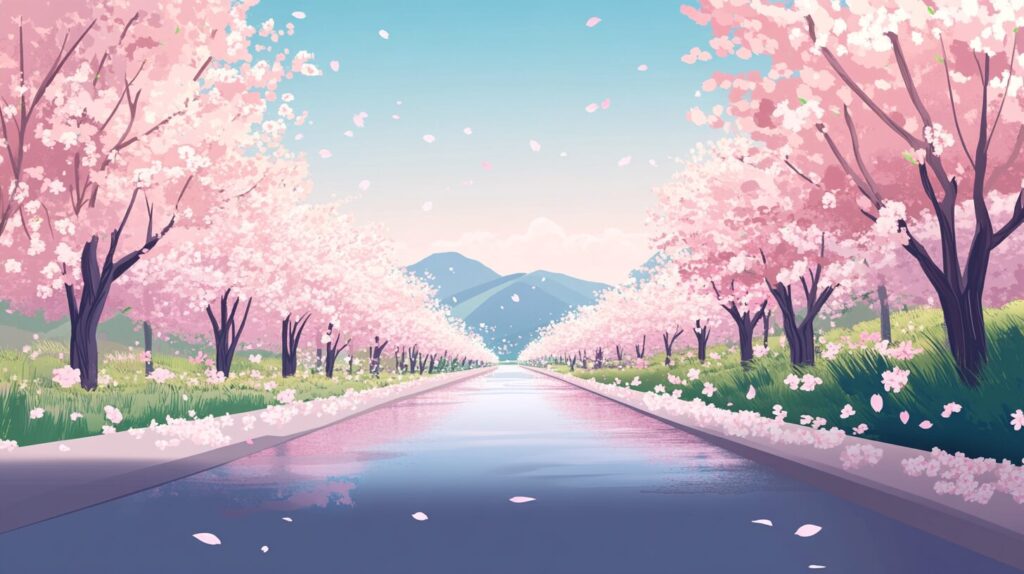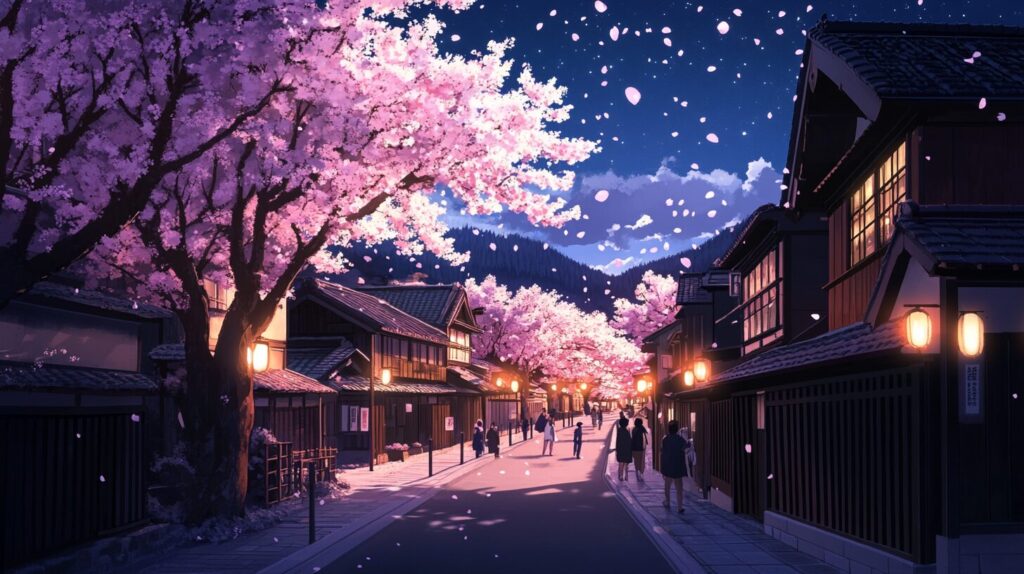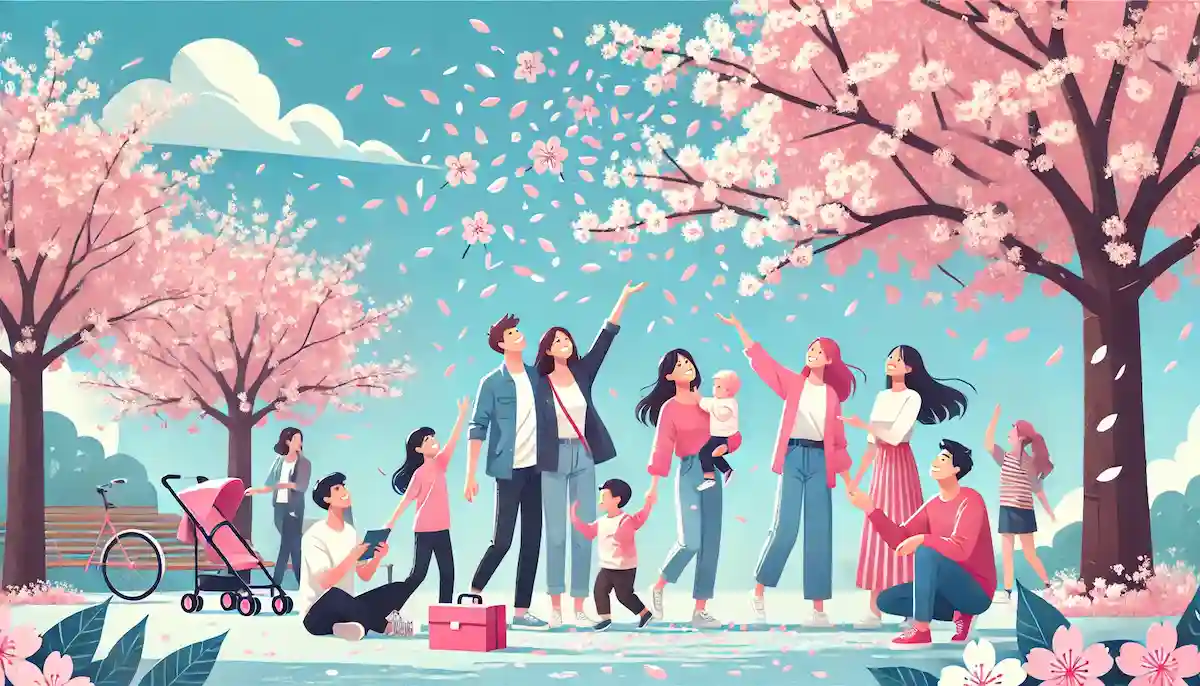みちのくの小京都 角館を英語で説明・紹介するための基本情報と、英会話に役立つ表現をシンプルでわかりやすい英語で紹介します。
英会話ダイアローグ・概要・10の質問を通して、角館に関する英語表現を学びます。
英語
英会話ダイアローグを読む前に知っておくと良い前提知識と情報です。
- 角館の基本情報
- 秋田県仙北市にある町で、「みちのくの小京都」と呼ばれている
- 江戸時代の歴史的な町並みや武家屋敷が有名
- 武家屋敷について
- 角館には今でも多くの武家屋敷が保存されている
- 青柳家、石黒家など、一部の屋敷は中を見学できる
- 桜の名所としての角館
- 約400本のしだれ桜が有名で、樹齢300年を超える桜もある
- 春には「角館桜まつり」が開催され、武家屋敷通りや桧木内川沿いが美しい桜のトンネルとなる
- 角館の主な祭り
- 毎年9月の「角館祭りのやま行事」は350年以上の歴史を持つお祭りで、ユネスコ無形文化遺産
- 祭りでは「曳山(ひきやま)」と呼ばれる豪華な山車をぶつけ合う伝統行事が行われる
- 樺細工(かばざいく)
- 桜の樹皮を使った角館特有の伝統工芸で、茶筒や小物入れなどが作られている
- 樺細工を実際に体験できる施設(樺細工伝承館)やお店がある
- 秋田の郷土料理
- 「稲庭うどん」や「きりたんぽ鍋」が有名で、角館でも味わえる
2人が角館について話しています。
「みちのくの小京都」と呼ばれる角館の武家屋敷や桜並木、伝統工芸の樺細工、郷土料理、祭りなどを話題にしています。
会話 / dialogue

Hey Key, I’ve been looking for a place to visit during cherry blossom season. Have you ever heard of Kakunodate?

Yeah! That’s the town in Akita Prefecture, right? It’s called the “Little Kyoto of Michinoku” because of its samurai district and amazing cherry blossoms.

That sounds awesome. So, what makes it special?

Well, for one, it has one of Japan’s best-preserved samurai districts. The samurai houses are from the Edo period, and some are still open to visitors. You can actually walk through them and see how samurai lived back in the day.

That’s really cool. Are the samurai houses big?

Some are. For example, the Aoyagi House is more like a museum now, with samurai armor, weapons, and furniture on display. The Ishiguro House is another famous one—it’s actually the oldest standing samurai house in Kakunodate.

That’s something I’d love to see. But you also mentioned cherry blossoms. What’s so special about them?

Kakunodate is famous for weeping cherry trees. There are about 400 of them, and some are over 300 years old! They look amazing in spring.

That must be breathtaking. Where’s the best place to see them?

There are two main spots. First, the Samurai District, where the pink blossoms contrast beautifully with the black wooden fences of the samurai houses. Second, Hinokinai River, where the cherry blossoms form a 2 km-long tunnel.

Wow, that sounds like a photographer’s dream. Is there a festival during the cherry blossom season?

Yeah, the Kakunodate Cherry Blossom Festival is held from mid-April to late April. They even light up the trees at night.

That must be magical. But Kakunodate isn’t just about cherry blossoms, right?

Nope! Another cool thing is the Kakunodate Festival in September. It’s over 350 years old and was recognized as a UNESCO Intangible Cultural Heritage event.

What happens during the festival?

They have these huge decorated floats (hikiyama) that are pulled through the streets. The crazy part is that they crash into each other on purpose!

Wait, they actually smash the floats into each other? That’s wild!

Yeah, it’s a tradition! The locals believe that how the floats crash decides the future of the town’s luck.

That sounds intense. What else is Kakunodate famous for?

Kabazaiku! It’s a traditional craft that uses cherry tree bark to make tea canisters, boxes, and accessories. You can even try making your own.

That’s interesting! I like unique souvenirs. Do they sell them in the Samurai District?

Yep, there are several shops selling high-quality Kabazaiku items. If you visit, you should check out the Kabazaiku Denshokan Museum to see how they make it.

I definitely will. By the way, what’s the food like there?

Since it’s in Akita Prefecture, you can try Inaniwa Udon, a thin type of udon noodles, and Kiritanpo Nabe, which is grilled rice sticks in a hot pot.

Sounds delicious. Is Kakunodate easy to get to from Tokyo?

Super easy! Just take the Akita Shinkansen, and you’ll be there in about 3 hours.

That’s great. I think I’ll plan a trip this spring!

Good idea! Just make sure to book early because cherry blossom season is the busiest time.

Thanks for the tip! I can’t wait to see the cherry blossoms and samurai houses.
概要 / Overview
「角館」について、理解を深めるための「英語での概要」です。
角館

Kakunodate – A Beautiful Historic Town
Kakunodate is a beautiful town in Akita Prefecture, northern Japan. People call it the “Little Kyoto of Michinoku” because it looks similar to Kyoto. It has many traditional houses and a peaceful atmosphere. The town is very popular with tourists, especially during cherry blossom season. Kakunodate is famous because it still looks the same as hundreds of years ago.
Samurai District
One special thing about Kakunodate is its Samurai District. Samurai were Japanese warriors, and they lived in this area long ago. Many of their houses are still here today, so visitors can walk around and imagine life during the Edo period. Two famous houses are the Aoyagi House and the Ishiguro House. Inside these houses, you can see old samurai armor, weapons, and furniture. Visiting these houses feels like going back in history.
Cherry Blossoms in Kakunodate
Another reason people love Kakunodate is its amazing cherry blossoms. There are about 400 weeping cherry trees in the town, and many are over 300 years old. In spring, these trees bloom with beautiful pink flowers. The best places to see them are the Samurai District and Hinokinai River. Hinokinai River has a 2-kilometer-long cherry blossom tunnel that is truly stunning. Every year, from mid-April to late April, the town holds the Kakunodate Cherry Blossom Festival, which is very popular with visitors.
Festivals and Traditional Crafts
In addition, Kakunodate has an exciting event called the Kakunodate Festival. Held each September, it’s a UNESCO Intangible Cultural Heritage event. People pull huge decorated floats through the streets. Kakunodate is also known for Kabazaiku, a traditional craft made from cherry tree bark. Visitors often buy Kabazaiku tea boxes as souvenirs to remember this charming town.
10の質問 / 10 questions
「角館」について、理解を深めるための「英語での10の質問」です。
1: Where is Kakunodate located?
Kakunodate is a historic town in Akita Prefecture, in northern Japan.
2: Why is Kakunodate called “Little Kyoto”?
Kakunodate is called “Little Kyoto” because it looks similar to Kyoto, with traditional houses, temples, and a peaceful atmosphere.
3: What is special about Kakunodate’s Samurai District?
The Samurai District has many well-preserved samurai houses from the Edo period. Visitors can explore these old houses and learn about samurai life.
4: What can visitors see inside samurai houses like Aoyagi House?
Visitors can see old samurai armor, weapons, and furniture, as well as traditional gardens.
5: Why is Kakunodate famous for cherry blossoms?
Kakunodate is famous for its beautiful weeping cherry trees. There are about 400 trees, many over 300 years old, that bloom beautifully every spring.
6: What happens during the Kakunodate Cherry Blossom Festival?
During the festival, people enjoy viewing cherry blossoms in the Samurai District and along the Hinokinai River. The cherry trees are lit up beautifully at night.
7: What is the Hinokinai River famous for?
The Hinokinai River is famous for its 2-kilometer-long cherry blossom tunnel, making it a popular spot for visitors during spring.
8: What is the Kakunodate Festival?
The Kakunodate Festival is an exciting event held every September. Large, decorated floats are pulled through the streets. It is recognized as a UNESCO Intangible Cultural Heritage event.
9: What is Kabazaiku?
Kabazaiku is a traditional craft from Kakunodate. It uses cherry tree bark to make beautiful tea boxes, trays, and small accessories.
10: How do you travel from Tokyo to Kakunodate?
You can easily travel from Tokyo to Kakunodate by the Akita Shinkansen (bullet train). The journey takes about three hours.

和訳付
会話 / dialogue

Hey Key, I’ve been looking for a place to visit during cherry blossom season. Have you ever heard of Kakunodate?
なあキー、桜の季節に行ける場所を探してるんだけど、角館って聞いたことある?

Yeah! That’s the town in Akita Prefecture, right? It’s called the “Little Kyoto of Michinoku” because of its samurai district and amazing cherry blossoms.
うん!秋田県にある町だよね?「みちのくの小京都」って呼ばれていて、武家屋敷と素晴らしい桜で有名なんだ。

That sounds awesome. So, what makes it special?
それはすごいな!で、角館の何がそんなに特別なの?

Well, for one, it has one of Japan’s best-preserved samurai districts. The samurai houses are from the Edo period, and some are still open to visitors. You can actually walk through them and see how samurai lived back in the day.
まず、日本でも最もよく保存された武家屋敷があるんだ。江戸時代の建物がそのまま残っていて、中には見学できるものもあるよ。当時の侍の暮らしを実際に体験できるんだ。

That’s really cool. Are the samurai houses big?
それはすごいな。武家屋敷って大きいの?

Some are. For example, the Aoyagi House is more like a museum now, with samurai armor, weapons, and furniture on display. The Ishiguro House is another famous one—it’s actually the oldest standing samurai house in Kakunodate.
大きい屋敷もあるよ。例えば、青柳家は今は博物館みたいな感じで、侍の鎧や武器、家具なんかが展示されているんだ。石黒家も有名で、実は角館で最も古い武家屋敷なんだよ。

That’s something I’d love to see. But you also mentioned cherry blossoms. What’s so special about them?
それはぜひ見てみたいな。でも、桜についても言ってたよね?角館の桜って何がそんなに特別なの?

Kakunodate is famous for weeping cherry trees. There are about 400 of them, and some are over 300 years old! They look amazing in spring.
角館はしだれ桜で有名なんだ。約400本もあって、その中には樹齢300年以上の木もあるんだよ!春には本当に圧巻の景色になるよ。

That must be breathtaking. Where’s the best place to see them?
それはすごいな。どこで見るのが一番いいの?

There are two main spots. First, the Samurai District, where the pink blossoms contrast beautifully with the black wooden fences of the samurai houses. Second, Hinokinai River, where the cherry blossoms form a 2 km-long tunnel.
大きく二つのスポットがあるよ。まず、武家屋敷通りでは、黒い木塀とピンクの桜のコントラストが美しくて、まるで別世界みたい。もう一つは、桧木内川の桜並木で、約2kmの桜のトンネルになるんだ。

Wow, that sounds like a photographer’s dream. Is there a festival during the cherry blossom season?
うわ、それは写真好きにはたまらないな!桜の時期にお祭りとかあるの?

Yeah, the Kakunodate Cherry Blossom Festival is held from mid-April to late April. They even light up the trees at night.
うん、角館桜まつりが4月中旬から下旬にかけて開催されるんだ。夜には桜がライトアップされて、すごく幻想的だよ。

That must be magical. But Kakunodate isn’t just about cherry blossoms, right?
それはまさに夢のようだな。でも、角館って桜だけの町じゃないよね?

Nope! Another cool thing is the Kakunodate Festival in September. It’s over 350 years old and was recognized as a UNESCO Intangible Cultural Heritage event.
そうだね!もう一つの大きなお祭りは、9月にある角館祭りだよ。350年以上の歴史があって、ユネスコ無形文化遺産に登録されているんだ。

What happens during the festival?
祭りでは何が行われるの?

They have these huge decorated floats (hikiyama) that are pulled through the streets. The crazy part is that they crash into each other on purpose!
「曳山」っていう巨大な山車が町中を引かれるんだけど、すごいのは、わざとぶつけ合うことなんだよ!

Wait, they actually smash the floats into each other? That’s wild!
え、本当に山車をぶつけ合うの?それはすごいな!

Yeah, it’s a tradition! The locals believe that how the floats crash decides the future of the town’s luck.
うん、それが伝統なんだ!地元の人たちは、山車のぶつかり方が町の運勢を左右するって信じているんだよ。

That sounds intense. What else is Kakunodate famous for?
すごく迫力ありそうだな。他に角館で有名なものって何かある?

Kabazaiku! It’s a traditional craft that uses cherry tree bark to make tea canisters, boxes, and accessories. You can even try making your own.
樺細工だね!桜の樹皮を使って作る伝統工芸で、茶筒や小物入れ、アクセサリーなんかがあるんだ。実際に作る体験もできるよ。

That’s interesting! I like unique souvenirs. Do they sell them in the Samurai District?
それは面白いな!ユニークなお土産が好きなんだ。武家屋敷通りで買えるの?

Yep, there are several shops selling high-quality Kabazaiku items. If you visit, you should check out the Kabazaiku Denshokan Museum to see how they make it.
うん、高品質な樺細工を売ってるお店がいくつもあるよ。行くなら樺細工伝承館で職人の技を見てみるといいよ。

I definitely will. By the way, what’s the food like there?
絶対行ってみるよ。ところで、角館の食べ物ってどんな感じ?

Since it’s in Akita Prefecture, you can try Inaniwa Udon, a thin type of udon noodles, and Kiritanpo Nabe, which is grilled rice sticks in a hot pot.
秋田県にあるから、稲庭うどんやきりたんぽ鍋が食べられるよ。

Sounds delicious. Is Kakunodate easy to get to from Tokyo?
それは美味しそうだな。角館って東京から行きやすいの?

Super easy! Just take the Akita Shinkansen, and you’ll be there in about 3 hours.
めちゃくちゃ簡単だよ!秋田新幹線で3時間くらい。

That’s great. I think I’ll plan a trip this spring!
それはいいな。春に行こうかな!

Good idea! Just book early because cherry blossom season is the busiest time.
いいね!でも桜の季節は一番混むから予約は早めにね。

Thanks for the tip! I can’t wait to see the cherry blossoms and samurai houses.
アドバイスありがとう!桜と武家屋敷が楽しみだよ!
概要 / Overview
角館

Kakunodate – A Beautiful Historic Town
Kakunodate is a beautiful town in Akita Prefecture, northern Japan. People call it the “Little Kyoto of Michinoku” because it looks similar to Kyoto. It has many traditional houses and a peaceful atmosphere. The town is very popular with tourists, especially during cherry blossom season. Kakunodate is famous because it still looks the same as hundreds of years ago.
角館 – 歴史ある美しい町
角館は、北日本の秋田県にある美しい町です。京都に似た風景を持つことから「みちのくの小京都」と呼ばれています。伝統的な建物が多く、静かな雰囲気があります。特に桜の季節には多くの観光客が訪れます。角館が人気なのは、何百年も前の姿をそのまま残しているからです。
Samurai District
One special thing about Kakunodate is its Samurai District. Samurai were Japanese warriors, and they lived in this area long ago. Many of their houses are still here today, so visitors can walk around and imagine life during the Edo period. Two famous houses are the Aoyagi House and the Ishiguro House. Inside these houses, you can see old samurai armor, weapons, and furniture. Visiting these houses feels like going back in history.
武家屋敷通り
角館の特別な見どころは「武家屋敷通り」です。武士とは日本の侍のことで、昔ここに住んでいました。その家の多くは今でも残っており、訪れた人は江戸時代の暮らしを想像しながら散策できます。有名な屋敷には青柳家や石黒家があります。屋敷内では昔の侍が使った鎧や武器、家具を見ることができます。ここを訪れると、まるで歴史の中に戻ったような気分になります。
Cherry Blossoms in Kakunodate
Another reason people love Kakunodate is its amazing cherry blossoms. There are about 400 weeping cherry trees in the town, and many are over 300 years old. In spring, these trees bloom with beautiful pink flowers. The best places to see them are the Samurai District and Hinokinai River. Hinokinai River has a 2-kilometer-long cherry blossom tunnel that is truly stunning. Every year, from mid-April to late April, the town holds the Kakunodate Cherry Blossom Festival, which is very popular with visitors.
角館の桜
角館が人々に愛されるもう一つの理由は、素晴らしい桜です。町には約400本のしだれ桜があり、その多くは樹齢300年以上です。春になると美しいピンク色の花が咲き誇ります。特に武家屋敷通りと桧木内川の桜並木が見どころです。桧木内川には約2kmに渡る桜のトンネルがあり、圧倒的な美しさです。毎年4月中旬から下旬にかけて「角館桜まつり」が開かれ、多くの観光客で賑わいます。
Festivals and Traditional Crafts
In addition, Kakunodate has an exciting event called the Kakunodate Festival. Held each September, it’s a UNESCO Intangible Cultural Heritage event. People pull huge decorated floats through the streets. Kakunodate is also known for Kabazaiku, a traditional craft made from cherry tree bark. Visitors often buy Kabazaiku tea boxes as souvenirs to remember this charming town.
祭りと伝統工芸
さらに、角館では毎年9月に「角館祭りのやま行事」という賑やかなお祭りが開催されます。この祭りはユネスコの無形文化遺産にも登録されています。人々は豪華な装飾をした巨大な山車を町中で引き回します。また、角館は桜の樹皮を使った伝統工芸「樺細工(かばざいく)」でも知られています。訪れた人は美しい樺細工の茶筒などをお土産として購入し、この魅力的な町を思い出に残します。
10の質問 / 10 questions
1: Where is Kakunodate located?
角館はどこにありますか?
Kakunodate is a historic town in Akita Prefecture, in northern Japan.
角館は北日本の秋田県にある歴史的な町です。
2: Why is Kakunodate called “Little Kyoto”?
なぜ角館は「小京都」と呼ばれているのですか?
Kakunodate is called “Little Kyoto” because it looks similar to Kyoto, with traditional houses, temples, and a peaceful atmosphere.
角館は京都に似た伝統的な家や寺院があり、落ち着いた雰囲気を持つことから「小京都」と呼ばれています。
3: What is special about Kakunodate’s Samurai District?
角館の武家屋敷通りの特別な点は何ですか?
The Samurai District has many well-preserved samurai houses from the Edo period. Visitors can explore these old houses and learn about samurai life.
武家屋敷通りには江戸時代の武家屋敷がよく保存されており、訪れる人は屋敷を見学して侍の生活について学べます。
4: What can visitors see inside samurai houses like Aoyagi House?
青柳家のような武家屋敷の中で、観光客は何を見ることができますか?
Visitors can see old samurai armor, weapons, and furniture, as well as traditional gardens.
観光客は昔の侍の鎧や武器、家具、そして伝統的な庭園を見ることができます。
5: Why is Kakunodate famous for cherry blossoms?
なぜ角館は桜で有名なのですか?
Kakunodate is famous for its beautiful weeping cherry trees. There are about 400 trees, many over 300 years old, that bloom beautifully every spring.
角館は美しいしだれ桜で有名です。町には約400本の桜があり、その多くは樹齢300年以上で、毎年春に美しく咲きます。
6: What happens during the Kakunodate Cherry Blossom Festival?
角館桜まつりでは何が行われますか?
During the festival, people enjoy viewing cherry blossoms in the Samurai District and along the Hinokinai River. The cherry trees are lit up beautifully at night.
祭り期間中、人々は武家屋敷通りや桧木内川沿いで桜を楽しみます。夜には桜の木が美しくライトアップされます。
7: What is the Hinokinai River famous for?
桧木内川は何で有名ですか?
The Hinokinai River is famous for its 2-kilometer-long cherry blossom tunnel, making it a popular spot for visitors during spring.
桧木内川は約2km続く桜のトンネルで有名で、春には観光客に人気のスポットとなります。
8: What is the Kakunodate Festival?
角館祭りとは何ですか?
The Kakunodate Festival is an exciting event held every September. Large, decorated floats are pulled through the streets. It is recognized as a UNESCO Intangible Cultural Heritage event.
角館祭りは毎年9月に行われる賑やかなお祭りです。豪華な飾り付けをした大きな山車が町を練り歩き、ユネスコ無形文化遺産にも登録されています。
9: What is Kabazaiku?
樺細工(かばざいく)とは何ですか?
Kabazaiku is a traditional craft from Kakunodate. It uses cherry tree bark to make beautiful tea boxes, trays, and small accessories.
樺細工は角館の伝統的な工芸品です。桜の樹皮を使って美しい茶筒やお盆、小物などを作ります。
10: How do you travel from Tokyo to Kakunodate?
東京から角館へはどのように行けますか?
You can easily travel from Tokyo to Kakunodate by the Akita Shinkansen (bullet train). The journey takes about three hours.
東京から角館へは秋田新幹線を使って簡単に行くことができます。所要時間は約3時間です。

words & phrases
英会話ダイアローグと関連情報に出てきた単語・フレーズです(例文は各3つ)。

district : 名詞
意味: 地区、区域。An area or region with specific characteristics or purposes.
(角館にある武士が住んでいた歴史的な区域を指して「Samurai District(武家屋敷通り)」として使用)
- Shibuya is a famous shopping district in Tokyo.
「渋谷は東京で有名なショッピング地区です。」 - He lives in the financial district.
「彼は金融街に住んでいます。」 - The city has a historic district near the river.
「その街には川の近くに歴史的な地区があります。」
awesome : 形容詞
意味: 素晴らしい、すごい、最高。Very impressive or extremely good.
(角館の魅力や素晴らしさを表現する際に、感動や称賛の気持ちを込めて使用)
例文:
- That concert was awesome!
「あのコンサートは最高だった!」 - You did an awesome job on your project.
「君はプロジェクトを素晴らしくやり遂げたね。」 - It’s awesome to finally visit Kakunodate.
「やっと角館に来られて最高だよ。」
float : 名詞(動詞の場合もあり)
意味: 山車、祭りで使われる装飾された移動式の台車。A decorated vehicle used in festivals or parades.
(角館祭りで使われる豪華に飾られた曳山(山車)のことを指す)
例文:
- The festival floats were decorated beautifully.
「祭りの山車は美しく飾られていました。」 - People pulled large floats through the town.
「人々が大きな山車を町中で引いていきました。」 - Each neighborhood builds its own float for the event.
「それぞれの地区がその行事のために独自の山車を作ります。」
smash : 動詞
意味: 激しくぶつかる、打ち砕く。To hit something very hard, breaking it or causing strong impact.
(角館祭りで山車同士が激しくぶつけ合う行為を指す)
例文:
- The two cars smashed into each other at the intersection.
「交差点で2台の車が激しく衝突しました。」 - He accidentally smashed the window with a ball.
「彼はボールで誤って窓を割ってしまいました。」 - The floats are designed to smash together during the festival.
「祭りの間、その山車はお互いに激しくぶつかるように作られています。」
intense : 形容詞
意味: 激しい、強烈な、緊張感のある。Very strong or extreme in feeling or strength.
(角館祭りの激しい山車のぶつけ合いを表現するとき、その迫力や強烈さを指す)
例文:
- The game became intense during the last few minutes.
「試合は最後の数分間、とても激しくなりました。」 - He felt intense pressure before the performance.
「彼は演技の前に強いプレッシャーを感じました。」 - The festival’s float crashing is very intense.
「祭りの山車のぶつけ合いはとても迫力があります。」
詳細情報 / Further Info
関連記事(お花見(桜の花見文化))

